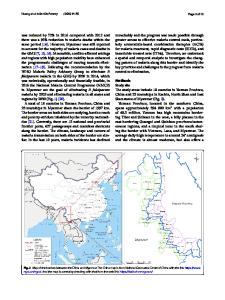Costing malaria interventions from pilots to elimination programmes
- PDF / 2,424,153 Bytes
- 14 Pages / 595.276 x 790.866 pts Page_size
- 21 Downloads / 345 Views
Malaria Journal Open Access
RESEARCH
Costing malaria interventions from pilots to elimination programmes Katya Galactionova1,2*, Mar Velarde1,2, Kafula Silumbe3, John Miller3, Anthony McDonnell4,5, Ricardo Aguas4,5, Thomas A. Smith1,2 and Melissa A. Penny1,2
Abstract Background: Malaria programmes in countries with low transmission levels require evidence to optimize deployment of current and new tools to reach elimination with limited resources. Recent pilots of elimination strategies in Ethiopia, Senegal, and Zambia produced evidence of their epidemiological impacts and costs. There is a need to generalize these findings to different epidemiological and health systems contexts. Methods: Drawing on experience of implementing partners, operational documents and costing studies from these pilots, reference scenarios were defined for rapid reporting (RR), reactive case detection (RACD), mass drug administration (MDA), and in-door residual spraying (IRS). These generalized interventions from their trial implementation to one typical of programmatic delivery. In doing so, resource use due to interventions was isolated from research activities and was related to the pilot setting. Costing models developed around this reference implementation, standardized the scope of resources costed, the valuation of resource use, and the setting in which interventions were evaluated. Sensitivity analyses were used to inform generalizability of the estimates and model assumptions. Results: Populated with local prices and resource use from the pilots, the models yielded an average annual economic cost per capita of $0.18 for RR, $0.75 for RACD, $4.28 for MDA (two rounds), and $1.79 for IRS (one round, 50% households). Intervention design and resource use at service delivery were key drivers of variation in costs of RR, MDA, and RACD. Scale was the most important parameter for IRS. Overall price level was a minor contributor, except for MDA where drugs accounted for 70% of the cost. The analyses showed that at implementation scales comparable to health facility catchment area, systematic correlations between model inputs characterizing implementation and setting produce large gradients in costs. Conclusions: Prospective costing models are powerful tools to explore resource and cost implications of policy alternatives. By formalizing translation of operational data into an estimate of intervention cost, these models provide the methodological infrastructure to strengthen capacity gap for economic evaluation in endemic countries. The value of this approach for decision-making is enhanced when primary cost data collection is designed to enable analysis of the efficiency of operational inputs in relation to features of the trial or the setting, thus facilitating transferability. Keywords: Malaria control, Malaria elimination, Costs, Malaria rapid reporting, IRS, RACD, MDA, Cost models, Resource-allocation, Comparative cost-effectiveness
*Correspondence: [email protected] 1 Department of Epidemiology and Public Health, Swiss T
Data Loading...











